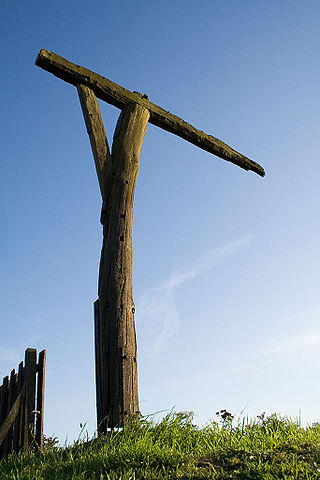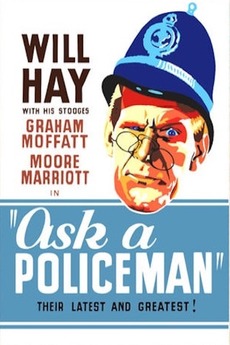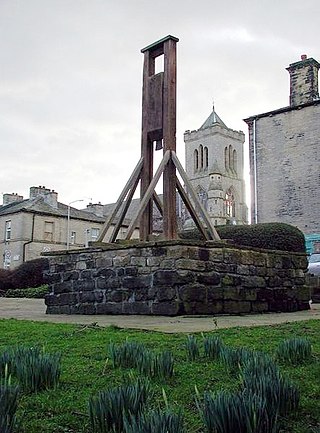
The Devil's Punch Bowl is a 282.2-hectare (697-acre) visitor attraction and biological Site of Special Scientific Interest situated just to the east of the village of Hindhead in the English county of Surrey. It is part of the Wealden Heaths Phase II Special Protection Area.

Louis Jeremiah Abershawe, better known as Jerry Abershawe, or Abershaw, was an English highwayman who terrorised travellers, mostly along the road between Kingston upon Thames and London, in the late eighteenth century.

Gibbeting is the use of a gallows-type structure from which the dead or dying bodies of criminals were hanged on public display to deter other existing or potential criminals. Occasionally, the gibbet was also used as a method of public execution, with the criminal being left to die of exposure, thirst and/or starvation. The practice of placing a criminal on display within a gibbet is also called "hanging in chains".

A gallows is a frame or elevated beam, typically wooden, from which objects can be suspended or "weighed". Gallows were thus widely used to suspend public weighing scales for large and heavy objects such as sacks of grain or minerals, usually positioned in markets or toll gates. The term was also used for a projecting framework from which a ship's anchor might be raised so it is no longer sitting on the seabed, riverbed or dock; "weighing [the] anchor" meant raising it using this apparatus while avoiding striking the ship's hull.

Professor Bernice Surprise Summerfield, or simply Benny, is a fictional character created by author Paul Cornell as a new companion of the Seventh Doctor in Virgin Publishing's range of original full-length Doctor Who novels, the New Adventures. The New Adventures were authorised novels carrying on from where the Doctor Who television series had left off, and Summerfield was introduced in Cornell's novel Love and War in 1992.
La Fin de Satan is a long religious epic by Victor Hugo, of which 5,700 lines were written between 1854 and 1862, but left unfinished and published after his death.

Inkpen is a village and civil parish in West Berkshire, 3.5 miles (5.6 km) southeast of Hungerford, most of the land of which is cultivated fields with scattered woodland once part of a former forest of Savernake. Inkpen has boundaries with Wiltshire and Hampshire, including parts of Walbury Hill, the highest point in South East England, and Inkpen Hill.

Ask a Policeman is a 1939 British comedy film directed by Marcel Varnel and starring Will Hay, Moore Marriott and Graham Moffatt.

Ultimate Power is a nine-issue comic book limited series published by Marvel Comics.
"Robin Hood and the Beggar" is a story in the Robin Hood canon which has survived as, among other forms, a late seventeenth-century English broadside ballad, and is a pair out of several ballads about the medieval folk hero that form part of the Child ballad collection, which is one of the most comprehensive collections of traditional English ballads. These two ballads share the same basic plot device in which the English folk hero Robin Hood meets a beggar.

The Halifax Gibbet was an early guillotine used in the town of Halifax, West Yorkshire, England. Estimated to have been installed during the 16th century, it was used as an alternative to beheading by axe or sword. Halifax was once part of the Manor of Wakefield, where ancient custom and law gave the Lord of the Manor the authority to execute summarily by decapitation any thief caught with stolen goods to the value of 131⁄2d or more, or who confessed to having stolen goods of at least that value. Decapitation was a fairly common method of execution in England, but Halifax was unusual in two respects: it employed a guillotine-like machine that appears to have been unique in the country, and it continued to decapitate petty criminals until the mid-17th century.

The black dog is a supernatural, spectral, or demonic hellhound originating from English folklore, and also present in folklore throughout Europe and the Americas. It is usually unnaturally large with glowing red or yellow eyes, is often connected with the Devil, and is sometimes an omen of death. It is sometimes associated with electrical storms, and also with crossroads, barrows, places of execution and ancient pathways.

Elsdon is a village and civil parish in the English county of Northumberland about 10 miles (16 km) to the southwest of Rothbury. The name is derived from the Old English meaning Elli's valley.

Dule trees, or dool trees, in Britain were used as gallows for public hangings. They were also used as gibbets for the display of the corpse for a considerable period after such hangings. These "trees of lamentation or grief" were usually growing in prominent positions or at busy thoroughfares, particularly at crossroads, so that justice could be seen to have been done and as a salutary warning to others. Place names such as Gallows-Hill, Gallows-See, Gallows-Fey and Hill of the Gallows record the site of such places of execution.

Bretforton is a rural village in Worcestershire, England, 4.4 miles (7.1 km) east of Evesham, in the Vale of Evesham. It is the largest farming village near Evesham. At the 2001 census, Bretforton had a population of 1,023 in 428 households. The area of the parish is 2.83 square miles.

Gibbet Hill, at Hindhead, Surrey, is the apex of the scarp surrounding the Devil's Punch Bowl, not far from the A3 London to Portsmouth road in England. The road used to pass close to Gibbet Hill, but has now been superseded by the Hindhead Tunnel and the road returned to nature.

Timestorm 2009–2099 is a 2009 Marvel Comics limited series. It was written by Brian Reed with pencils by Eric Battle. The series is a crossover between the mainstream Marvel Universe and a universe very similar to, but with notable differences from, the Marvel 2099 universe.

The Unknown Sailor was an anonymous seafarer murdered in September 1786 at Hindhead in Surrey, England. His murderers were hanged in chains on Gibbet Hill, Hindhead the following year.

A View from a Hill is a short film which serves as the ninth episode of the British supernatural anthology series A Ghost Story for Christmas, and the first episode of its revival following the 1971–78 run. Written by Peter Harness, produced by Pier Wilkie, and directed by Luke Watson, it is based on the ghost story of the same name by M. R. James, first published in the collection A Warning to the Curious and Other Ghost Stories (1925), and first aired on BBC Four on 23 December 2005.

Jörgenberg Castle is a castle in the municipality of Waltensburg/Vuorz of the Canton of Graubünden in Switzerland. It is a Swiss heritage site of national significance.

















